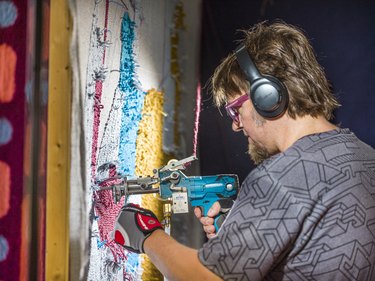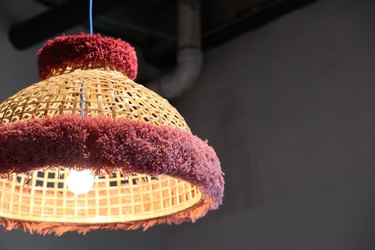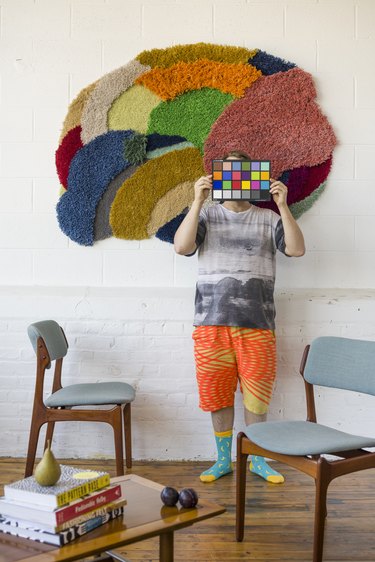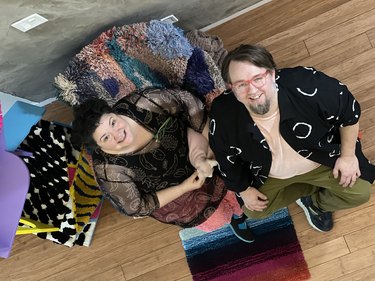Tim Eads and Tiernan Alexander didn't set out to fall in love with tufting. Five years ago, the Texas-born, Philly-based husband and wife duo were doing their usual creative work—making ceramic pieces and fiber art, plus running a screen-printing and cut-and-sew tote bag business. Then a friend suggested Tim try tufting, aka the practice of making rugs and other plush pieces using a gun-shaped handheld sewing machine.

Video of the Day
Tim stretched a piece of cloth onto a large wooden frame and clipped it to a table, sketched out a pattern for his rug on the cloth, loaded the tufting gun with yarn and pressed the trigger, moving around against the fabric. Within a few hours, he had stitched his first rug. "Initially, I thought I'd be putting bits of tufting on bags. I thought, 'I already have a business. I don't need to start another,'" Tim recalls. "But when I posted a video of tufting rugs on social media, it took off in a way nothing else had."
Video of the Day
"Took off" is an understatement. That 2018 foray into tufting became Tuft the World, Tim and Tiernan's multimillion-dollar business. In addition to hosting online and in-person tufting workshops, Tuft the World supplies crafters with tufting guns, yarn and other accessories. But the couple's impact extends beyond dollars. When they got into the art form, tufting was done almost exclusively by companies selling rugs and virtually nonexistent as a craft.
Tim and Tiernan set out to change that by making tufting guns and equipment accessible to the public. In doing so, they helped pioneer a craft that has grown exponentially in the past three years. The duo also opened an education center in Philly for workshops and recently hosted the first-ever tufting convention, Tuftcon, in the city. "When you find something you love doing and it grows into something a lot of people love, you feel so much excitement," Tiernan says. "It's such a creative boost."
We chatted with Tim and Tiernan about the rewards of creating a craft community, building a business that actually treats employees fairly and how any crafter can turn tufting from a hobby into a profitable side hustle.
What opened your eyes to tufting’s potential as a craft for everyone?
TIM: When I tried it, there was an immediate satisfaction that many crafts don't have. With a lot of other crafts, you have to build up to a finished product. With tufting, if you pick up a machine and have the right materials, you'll be holding a rug in a few hours. If you manage not to poke yourself and can tie your hair in a ponytail (so it doesn't get caught), you can tuft. It's as simple as that.
Tufting as a craft didn’t really exist when you started Tuft the World. What were the early days like?
TIERNAN: There were no classes, no manuals. Tim taught himself how to repair the machines, how to thread and how to build a frame, then posted videos about it on social media. Once we understood there was a lot of interest, we started buying tufting machines wholesale, 20 at a time, and imported everything in bulk, from the very specific cloth needed to the tough yarn required. From 2018 to 2020, we did everything out of our house in Philadelphia—making frames in the garage, counting yarn in the basement. We had our fulfillment center on the first floor! Every time we found something we loved, like a new machine or a new yarn, we'd add it on.
TIM: In 2019 alone, we did 32 workshops and taught 600 people. We drove to Canada, Baltimore, you name it.
TIERNAN: Then in 2020, business completely exploded during the pandemic. Suddenly tufting was everywhere.
Since 2018, you've built a pretty extensive online community, which is now 10,000 tufters strong.
TIERNAN: That was one of our biggest goals from the beginning: an online community where people could share their knowledge. Our philosophy is the more people who know about this, the more fun it is. There's no weird gatekeeping in tufting. People want to show off their techniques and help others.
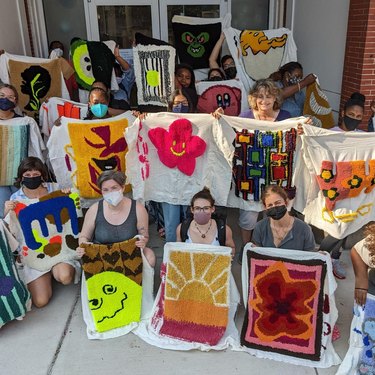
Why do you think tufting has such a devoted following?
TIERNAN: I think it's absolutely about the thrill of making something that you can't really buy—your design, your color choices, your ideas are what make a piece completely unique. And the finished rugs look amazingly professional. They are handmade but also have a certain amount of finesse.
And let's not forget, the story of humans is really one of making. The satisfaction of creative endeavors such as tufting is so innate, going all the way back to hand prints on ancient cave walls. A design process uses one kind of creative thinking, but tufting a design has a quality similar to what it was like to color as a child. All you need to do is fill in spaces with the right color and the image comes to life. There's a playful quality to tufting because of that.
Also, because you can work so quickly with tufting, you can try new ideas in rapid succession and narrow in on what's most interesting or exciting for you. Working on just a few rugs, you start to find what you enjoy the most while also pushing your skills forward. The satisfaction of learning, becoming skilled, finding your artistic voice and sharing what you've produced with others keeps going as you make more tufted work.
Tufting 101: What You Need to Start Tufting
Inspired to start tufting? It's pretty easy, says Tiernan Alexander of Tuft the World. "Getting started requires only a machine, frame, fabric and yarn." To remove the guesswork, Tuft the World sells a starter kit that includes a dual machine, buildable frame kit and one yard of primary tufting cloth.
Here's what you need to jump-start your tufting journey:
Tufting gun: For a whole range of options, check out our guide to the best tufting guns. "Like most crafts, there's a wide range in quality and cost of supplies," Tiernan adds. So do your research before pressing the buy button.
Tufting cloth: Tim and Tiernan recommend tightly woven commercial-grade primary tufting cloth for maximum durability. Lower-priced monks cloth is also popular in the craft.
Wooden frame: You'll need a wooden frame to stretch the tufting cloth on, like a small 28 in. square one that you can assemble yourself. These retail for about $60 on Amazon.
Yarn: Tim and Tiernan recommend using sturdy tufting-specific yarn (not to be confused with acrylic knitting or crocheting yarn). Tuft the World sells wool, recycled cotton and banana silk options. Amazon sells a tufting yarn package with six medium cotton/polyester rolls in varied colors for $62.
C-clamps: You can use a C-Clamps Set to secure a wooden frame to a table and create a stable tufting environment.
A simple design: Some tufters draw design freehand on cloth, while others use a projector to superimpose a design onto cloth and trace it with a pencil. "Keep in mind: You tuft from the back, so your finished design will be the reverse of what you draw," Tiernan says.
Safety protocols: "Remember to keep the tufting gun turned off when you're threading it," Tiernan says. "You want to cradle the machine in the crook of your arm, like a small dog, so you can use both hands to thread in the yarn. The biggest mistake people make is not pushing into the fabric hard enough. If it feels like the machine is stuttering or kicking back, lean into the fabric more firmly."
Community: The Tuft the World Community page has thousands of members sharing advice, art and ideas. "It is the largest resource of tufting knowledge anywhere," Tiernan says.
Do a lot of tufters eventually sell their work?
TIERNAN: A lot of folks who get into craftwork want to have a go at a business. Though the starting cost for tufting is about $500 (for the machine, a frame, tufting cloth and yarn), you can make a rug in a reasonable period of time and sell it for a price that supports you. The number of personal rug businesses that have popped up because of that is inspiring. We have an affiliate program through which we sponsor tufters' social media videos and posts. They get store credit for any business their content sends our way. In the case of one very talented tufter, @ajmakes, we received so much business from her videos that we were able to pay her in cash so she could quit her job to tuft full-time and be the artist she is.
You also seem very supportive when it comes to your employees.
TIERNAN: Once we started hiring people in 2020, we wrote down what kind of company we wanted to be. We calculated that in order to be okay financially in Philadelphia, a living wage should be at least $25 an hour. We set a goal to pay our 20 employees that amount by the end of this year. We've already reached that goal, and we all make the same per hour.

Did I hear that right? You and Tim earn the same as all your employees?
TIERNAN: Yes. You seldom in your life have the opportunity to have this much money flowing through your hands. We set up a company with the goal of treating people well. Everybody who works here has fully paid health care, paid parental leave, paid bereavement leave, life insurance, short- and long-term disability and matching 401k. All those things that are so critical. And you know how you do it? Don't pay yourself all the money. That's it. All Tim and I want is a job we can deal with.
Wow. Can I work for you?
TIERNAN: Oh, and it's a four-day workweek because most of our staff are artists. You can't be an artist and work five days a week. When are you going to make your work?
You're also huge sustainability advocates.
TIM: Yes, we sell recycled yarn as well as yarn made from banana fiber. We've also invested in a machine that breaks down old cardboard boxes to use as packing material instead of plastic. And since 2021, we've partnered with a nonprofit to plant a tree for every purchase since 2021. So far, we've planted more than 28,000 trees around the world.
Has tufting brought you two closer together as a couple?
TIERNAN: This is the first time we've really worked together on a daily basis. The best part is that we have such different skills. We complement one another and are better together than we would be on our own. We also challenge each other, so if one of us has a bad idea, the other can step in and talk them down. The harder part of doing everything together is that, even on vacation, we are always talking about work!
What’s next for Tuft the World?
TIM: A couple of years ago, I bought a CNC robo-tufting machine. The installer is coming from China to install it. I plan to use it to design rugs for sale and have limited edition rugs from artists we love.
TIERNAN: People can get really jaded and feel like everything cool has already been invented. But it's not true. There's always more fun to be had!
